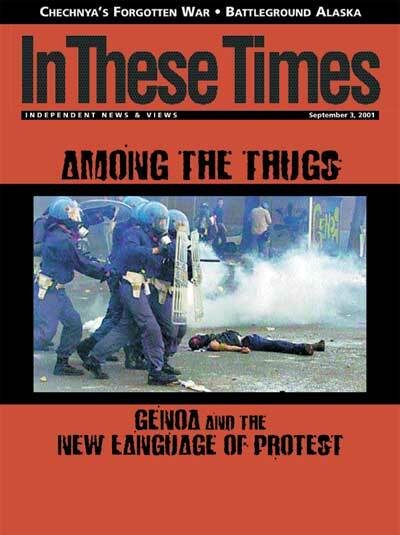Resource Wars: The New
Landscape of Global Conflict
By Michael T. Klare
Metropolitan Books
289 pages, $26
A little-noticed bump in that ongoing American experiment recently protested in Quebec, Gothenberg and Genoa occurred in September 1997, within the Army’s Operation CENTRAZBAT 97, when 500 82nd Airborne Division paratroopers became the first American soldiers to deploy in the onetime Soviet satellite state of Kazakhstan.
Ostensibly, this military exercise involved our supporting the
nascent independent nations of Kazakhstan, Kyrgyzstan and Uzbekistan against purported
“renegade forces.” But a more plausible justification for such an
out-there demonstration–
involving the longest-distance airborne operation in history–
concerns the enormous petroleum deposits of the Caspian Sea basin.
That petroleum belongs not to the Russians now, but to the marketplace.
As Deputy Secretary of State Strobe Talbott put it that same year,
“It would matter profoundly to the United States” if American oil
interests were denied access to “an area that sits on as much as 200
billion barrels of oil.”
While the notion of “war for oil” was a rallying cry against the 1991 Gulf War, officials like Talbott now are more candid about military supervision of petroleum’s westward flow. Indeed, the record-setting paratroop drop may preview the future of America’s militarized pursuit of increasingly scarce natural resources.
Michael T. Klare sees such a future in Resource Wars, his ninth book on military affairs. With a coolly expansive perspective, Klare identifies numerous locations worldwide where the intersection of security conflicts, geography, and supply and demand may provoke violent battles over essential resources within our lifetimes. Klare foretells a decisive return to pre-Cold War priorities, when nation-state brinkmanship over resources was always evident, from the violent excursions of 19th-century colonialism to the last years of World War II, when the Axis war machine became overextended in direct proportion to its hunger for raw materials. The crucial difference, however, is the enormous change in population density, technology and environmental stress since 1945.
What Klare terms “the competitive pursuit of petroleum plenty” is central to his model of future resource wars. Klare regards the Persian Gulf as the region most likely to experience conflict in the decades ahead, especially considering the region’s ongoing and bitter schisms. Tracing a long history of British and American intervention supplementing the region’s internal conflicts, he notes that the oil price inflation of the ’70s allowed the Arab states to modernize their own arsenals, while the “Carter Doctrine” of 1980 virtually legitimized all manner of military intrusion by U.S. troops.
More wars over oil in the Middle East seem like an obvious prediction, but Klare’s work is valuable because it is so attuned to the big picture. As he makes clear, major conflagrations are just as likely to develop around, say, China’s heavy hand in asserting control over minor offshore territories like the Spratly Islands, beneath which lie potentially vast undersea reserves. There already have been armed skirmishes over these islands between China, Vietnam, Malaysia and the Phillipines; these nations (along with Singapore and Japan) quietly have refitted once-modest navies for deep-sea warfare, all of which implies that future clashes could quickly envelop U.S. forces.
While Klare is no alarmist, he offers a ghastly glimpse into future decades. He plausibly concludes, for instance, that half of the world’s known liquid petroleum supplies will be consumed by 2020, with total depletion foreseeable between 2040 and 2060. Furthermore, barring substantial new discoveries, the domestic U.S. petroleum reserve, an estimated 28.6 billion barrels in 2000, will likely be consumed by 2010. While one might hope for “greener” solutions in response to this Road Warrior scenario, Klare demonstrates that issues of resource “protection” have already been ceded to the U.S. military, rather than to diplomatic or economic initiatives.
While contemporary warfare and petroleum seem fundamentally inseparable, we here at home in the Brita Nation may consider water a benign, mundane element of living. Yet Klare notes, “In a vast area stretching from North Africa to the Near East and South Asia, the demand for water is rapidly overtaking the existing supply.” As with the pending conflicts over fuels, the nations facing these shortages possess engorged militaries (often due to proxy arming during the Cold War) that engage in intractable internecine warfare, exemplified by the sort of bloody, low-intensity combat of the Ethiopia-Eritrea war.
Even in relatively stable nations, that many of these contested water sources cross borders practically guarantees protracted conflicts; often, upstream riparians (possessors of underground aquifers or river headwaters) are “muscled out” of their proportionate share of fresh water by downstream aggressors. For example, while Egypt makes no actual contribution to the Nile’s annual flow, it has consistently “appropriate[d] the great bulk of its waters for its exclusive use” through military action in northeast Africa. As Anwar el-Sadat once commented, “The only matter that could take Egypt to war again is water.”
Given that freshwater usage outpaced population growth by 3-to-1 between 1950 and 1990, Klare concludes that at that rate of increase humanity could be consuming 100 percent of the world’s renewable freshwater supply in two or three decades – if that water were divided evenly without geopolitical prejudice. But, as Klare tragically observes, water isn’t distributed evenly: Conflicts in the Third World – particularly around the Jordan, Tigris-Euphrates and Indus river basins – already seem inevitable.
Klare’s chapter on “Fighting for the Riches of the Earth” reflects on locales like Sierra Leone and Liberia, where the postwar, post-colonial social contract has been obliterated by the child soldiers and machete-wielding thugs of minor autocrats with excellent money-laundering services.
Klare shows exactly how the traffic in diamonds and other commodities is directly connected to the spasms of warfare conducted by violent splinter groups like Sierra Leone’s Revolutionary United Front, and how the 25-year factional struggle in Angola has mutated from an ideological clash to an oil-and-gem grab. It’s an amazing confirmation of efficient free-market savagery for the new century. As with oil-related strife in places like Nigeria, mainstream corporations such as De Beers abet economic devastation and bloodshed by “purchasing diamonds, minerals, timber and other commodities from the combatants.”
Meanwhile, the postmodern warfare business entrenches itself in these conflicts: Private military companies, like Britain’s Sandline International, now function as heavily armed temp agencies, selling the service of downsized military personnel to the highest bidder, with contracts running into the tens of millions and few questions asked.
Klare also reminds us that this militarized resource grab has dire consequences for the remaining native peoples in the rugged interiors where most commodity extraction occurs. In the case of the Malaysian Dayak, the government-sponsored logging of their forested homeland has created a long-simmering conflict, which erupted in 1997 with atrocities committed by Dayak militias, the regular Army and the private security employed by logging interests.
Klare views these far-flung conflagrations not as “random or disconnected events” but as “part of a larger, interconnected geopolitical system.” In his vision, the “political and ideological considerations” with which we normally associate protracted interstate conflicts are rapidly becoming window-dressing for the struggle over essential resources.
Klare’s is a rigorous and coolly executed work with sobering implications for the next several decades of life on earth. While his scholarship cannot be faulted, perhaps his restrained tone ultimately limits his vision. He neglects certain phenomena of capitalism that feed directly into projections of resource scarcity. Consider the triumph of American consumerism: As the SUV cult blights the nation with an insane volume of light-truck traffic, parallel enthusiasms strew badly constructed McMansions through the suburbs, needlessly pushing the planet’s limits.
Likewise, Klare declines to discuss the militarized drug war that is transforming portions of Mexico, Colombia and other nations into charnel houses – an entirely different but no less tragic model of resource conflict. While Klare’s basically acultural perspective sways the reader through sheer mastery of facts, these elements – our domestic profligacy and law-and-order hypocrisy – would add an essential chiaroscuro to his clean lines. Our culture points to a ruthless resignation already in place that arrives straight out of the European 1930s, a collective psychic assent to the coming era of violence, pollution and thirst.






